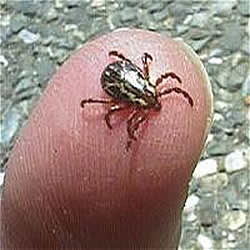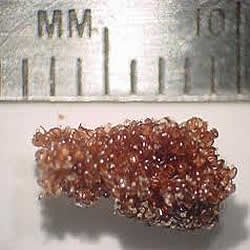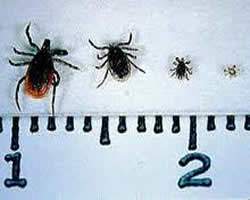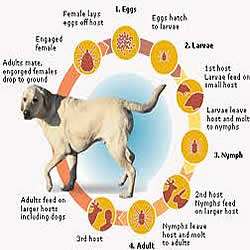We’ve had several people ask about ticks on dogs and what they look like on our Ask A Pet Pro blog. Here are some pictures of ticks and their eggs and baby ticks (known as seed ticks).

Dog Tick

Tick Eggs

Seed Ticks

4 stages of a tick

Tick life cycle
Ticks have a life cycle and are usually found on grasses and shrubs outside where they can drop on a warm passerby.
Here is some information from “The Family Vet” website on ticks.
Ticks have four life stages: egg, six-legged larva, eight-legged nymph and adult. After the egg hatches, the tiny larva (sometimes called a “seed tick”) feeds on an appropriate host. The larva then develops (molts) into the larger nymph. The nymph feeds on a host and then molts into an even larger adult. Both male and female adults find and feed on a host, then the females lay eggs sometime after feeding.
Ticks wait for host animals from the tips of grasses and shrubs (not from trees). When brushed by a moving animal or person, they quickly let go of the vegetation and climb onto the host. Ticks can only crawl; they cannot fly or jump. Ticks found on the scalp have usually crawled there from lower parts of the body. Some species of ticks will crawl several feet toward a host. Ticks can be active on winter days when the ground temperatures are about 45o Fahrenheit.
There are two groups of ticks, sometimes called the “hard” ticks and “soft” ticks. Hard ticks, like the common dog tick, have a hard shield just behind the mouthparts (sometimes incorrectly called the “head”); unfed hard ticks are shaped like a flat seed. Soft ticks do not have the hard shield and they are shaped like a large raisin. Soft ticks prefer to feed on birds or bats and are seldom encountered unless these animals are nesting or roosting in an occupied building.
Ticks prefer to attach on the head and neck, in the ears, around the anus, near the shoulder blades, and between the toes. A male and a female tick will usually attach together with the female becoming quite large as she engorges with blood. The female will detach and lay thousands of eggs in the environment. (Up to 2000 at a time!) These eggs hatch into larval ticks called “seed ticks” which sometimes are seen by the thousands on some dogs. Seed ticks must feed on blood from a dog or other mammal, then they fall to the ground and molt into a “nymph” stage. Again, the nymphs must find a mammalian host, feed on blood, and again fall to the ground and molt into adults.
When the adults find a host to feed on, the cycle is completed and begins again. This whole cycle can take from 2 months up to 2 years, and will tend to proceed faster in warm, moist weather. Because all life stages can feed on your dog, and because ticks lay large quantities of eggs, tick problems can escalate rapidly. Frequent and consistent treatment will be essential to ending and controlling the problem.
CONTROL OF TICK INFESTATION
There is no one-plan-fits-all strategy, but in short, killing and repelling ticks on the dog, and destroying and removing the eggs and nymphs from the house and yard are essential parts of any strategy.
It is best to work with your veterinarian to select safe and effective products. There are hundreds if not thousands of products sold today, many that are unproven and unsafe. Your veterinarian will generally have the latest improvements and safest agents available. Avoid untrained pet store personnel who have little training in chemistry and parasite control. Most are simply trying to sell you a product, not treat your pet in the best possible manner.
TOPICAL REPELLANTS such as Frontline tm and Advantage tm, are applied to the skin of the dog or cat where they spread out and over the entire skin area. These provide a sort of total body flea collar and are very effective in killing and repelling fleas. These agents have minimal toxicity for most pets: side effects are very rare. This is considered the “state of the art” in flea and tick control today. Avoid “knock off” products. We have seen poor performance and some severe toxic reactions from many off-brand chemicals sold in pet and retail stores.
DIPS provide quick and effective tick kill and can usually be mixed from a concentrate and poured or sponged onto your dog. You must dip about every two weeks as the dip will weaken in about that time. Do not rinse off the dip to provide residual anti-tick activity. We have had great success with Paramite Dip.
TOPICAL SPRAYS work well to quickly kill ticks, and a few will provide residual protection or prevent eggs from hatching out later. Sprays can be used between dipping, and in conjunction with topical and systemic medications. Alcohol-based sprays work best, but some people and dogs may be bothered by the fumes, so less effective water-based treatments are also available. Please ask about products currently available.
SHAMPOOS also kill adult ticks, and assist in cleaning eggs and dirt from the coat, but have minimal residual activity or effectiveness against tick eggs. Using shampoo then dipping or using a spray is the best strategy.
TICK COLLARS, if they are high quality, can help kill and repel ticks, but should be viewed as part of a tick control program and not as an end to the problem. Poor quality collars can be toxic to your dog, and can irritate the skin on the neck of your pet, so avoid the grocery store brands. Some new collars like Preventictm release their chemical ingredient onto the skin and not only kill and repel ticks, but prevent the transmission of tick-borne diseases. We do carry the Preventic collars but most people today opt for the topical Frontline.
FOGGERS and SPRAYS for the house and yard are useful in controlling the balance of your tick population. Newer foggers have time-release agents and providing kill for weeks after application. Many contain growth regulators to inhibit the hatching of eggs already in the environment. Foggers also apply their chemicals EVERYWHERE which happens to be where the ticks live, so these can be very useful in getting a bad tick problem quickly under control. Many sprays work in similar fashion but are better suited for direct application to baseboards and bedding areas where the heaviest infestations will occur.
Spaying the yard, grass, fences, patios and dirt areas with a yard spray made for ticks is also important to get tick problems under control. Spraying may be needed every 7-10 days in warmer weather, and you can do it yourself or hire professional exterminators to do the job for you. Be careful to keep your dogs away from freshly sprayed areas until they are dry. Most veterinarians will carry high quality yard sprays for home use.






